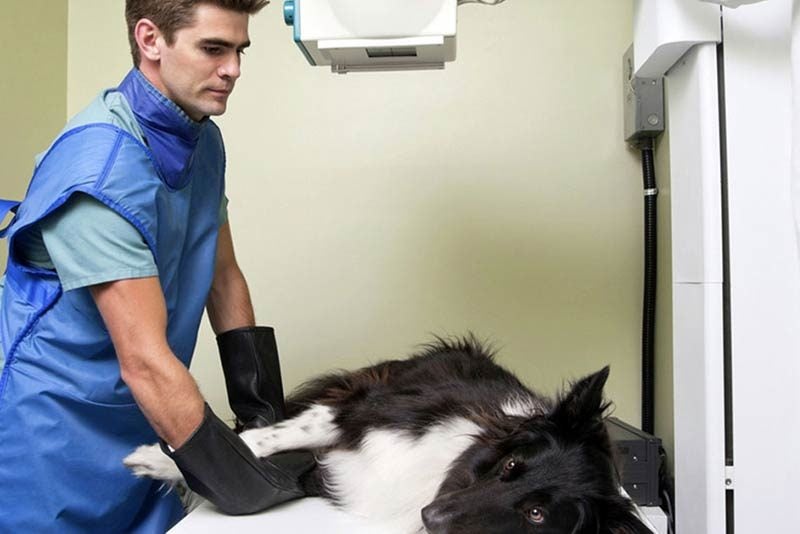
Like people, dogs have a tube called a trachea (also known as a windpipe) that connects their throat and lungs. Located along the wall of the trachea are small cartilage rings and tissue membrane. In certain dog breeds or older dogs, these may weaken or collapse. If that membrane starts to sag and the cartilage rings flatten, your dog may suffer from collapsed trachea.
A collapsed trachea in dogs is a progressive condition, meaning it gets worse as time goes on. Tracheal collapse makes it difficult for dogs to breathe and get air to their lungs. Here’s what you need to know about collapsing trachea, including causes, symptoms, and treatment options.
Causes of Collapsed Trachea in Dogs
If your dog has any breathing difficulties, this is a medical emergency and requires immediate veterinary attention. But what exactly is a collapsing trachea in dogs? Inside your dog, C-shaped cartilage rings that lie on top of one another support the trachea. Three of the four sides of the trachea are made up of cartilage, while the back section (the dorsal portion) consists of a soft membrane. This membrane can loosen with age, although for some dogs it’s also possible to display collapsing trachea at a very young age.

In a healthy dog, the trachea is supposed to be relatively stiff. This promotes airflow and allows the windpipe to maintain its tube-like shape. “When there is collapsing trachea, some of the rings become flaccid and flatten, causing the trachea to narrow and collapse,” says Dr. Jerry Klein, DVM, Chief Veterinary Officer for the American Kennel Club. In other words, a part of the trachea may collapse and fall into the airway, making it harder for a dog to breathe in and out normally.
Collapsing trachea in dogs usually occurs in middle-aged and older dogs. “This condition often worsens over time and is usually seen in certain toy breeds,” Dr. Klein says. “The cause of this condition is not entirely clear, but the current consensus is that [there are likely] many factors are involved, primarily genetic with possible allergic and nutritional triggers.” For example, it’s possible that there is a hereditary reason for the cartilage in the C-shaped rings flattening out.
Canine tracheal collapse tends to be more common in smaller dogs, but it can happen in any breed. The symptoms of collapsing trachea may get worse if your dog is obese or has heart issues, so it’s important to help your dog maintain a healthy weight.
Symptoms of Collapsed Trachea in Dogs
Dogs with a collapsing trachea often develop a dry, honking cough. It can resemble the sound geese make when they’re flying overhead. Situations that may make the cough worse include:
- Hot and humid weather
- Exposure to very high or very low temperatures
- Putting pressure on the dog’s neck
- Eating food
- Drinking water
- Inhaling substances that irritate the dog’s airway
- Intense exercise
- Stress
- Getting overly excited

The cough may also get worse at night. A dog may experience periods of respiratory distress (having difficulty breathing) that involve frequent and violent coughing. These episodes of uncontrollable dog coughing can last for several minutes, but they will usually resolve themselves. However, these coughs doesn’t produce any phlegm or nasal discharge.
Other symptoms of collapsing trachea in dogs include severe panting, fainting, and mucous membranes turning a bluish color. You also won’t see fever in dogs with a collapsed trachea.
Diagnosing Collapsed Trachea in Dogs
“Tracheal collapse is usually diagnosed by clinical signs and imaging techniques,” Dr. Klein says. Your veterinarian will also conduct a physical exam, examining the neck (which may make your dog start coughing).
They may also examine your dog with imaging methods like canine radiography or fluoroscopy. Radiography involves using X-rays to examine internal parts of the body and look for signs of disease. Fluoroscopy refers to the use of X-rays to create a real-time video of the inside of a dog’s body.
Your vet may use an endoscope. Inserting this tool (which usually has a light and camera) into your dog’s body lets the vet see internal organs. A bronchoscope is similar, but it specifically lets your vet examine the lungs.
Preventing Collapsed Trachea in Dogs
Unfortunately, there is no cure for tracheal collapse. Because genes likely play a role in dog developing a collapsed trachea, there isn’t a known way to prevent it at this time. While it can’t be prevented or fully cured, the symptoms can be managed to help your dog’s quality of life.
Treating Tracheal Collapse in Dogs
Many dogs with mild collapsed trachea do respond to continued medical management of the condition and its symptoms. Your vet may recommends different methods of tracheal collapse treatment and management, including:
- Managing your dog’s weight
- Assessing and treating any lung diseases (like chronic bronchitis) or heart disease
- Relieving discomfort with medications, including cough suppressants for dogs, anti-inflammatories for dogs (such as canine corticosteroids), and bronchodilators
- Relieving the dog’s anxiety and panic with dog calming products
- Reducing any swelling and tissue irritation
- Keeping airways open
- Preventing secondary infection with antibiotics for dogs
- Using a dog harness instead of a dog collar (to avoid putting pressure on the dog’s throat)
- Reducing exposure to potential airway irritants, like cigarette smoke, wildfire smoke, fragrances, and air fresheners
- Limiting dust and allergens in their environment
- Avoiding hot and humid environments
- Adjusting your dog’s exercise routine to make sure they’re not straining themselves

What Happens if My Dog Has a Collapsed Trachea?
Collapsed tracheas are serious conditions and the symptoms can range in severity. “The prognosis for tracheal collapse depends on the severity of the disease and the dog’s response to medical management,” Dr. Klein says. “In severe cases, a dog’s quality of life can be compromised.” If managing their condition in these ways doesn’t help, dogs may require surgery.
Surgery for Collapsed Trachea in Dogs
Surgery could potentially help certain dogs with collapsed tracheas. “These are dogs with significant breathing difficulties, or signs that do not respond to treatment causing a significant loss of quality of life for the dog,” Dr. Klein says. Consult your vet on how to help your dog with their collapsed trachea, as surgery could work for some cases, but not all.
A board-certified veterinary surgeon will decide whether to perform surgery, depending on the exact location of the tracheal collapse and the size of the area involved. Surgery aims to stabilize the cartilage rings permanently, while also supporting the blood supply to the area. A vet may do this by inserting a prosthetic ring around the trachea or putting a mesh stent inside the trachea. “Unfortunately, not all dogs can benefit from surgery and the surgical procedure itself carries some risk of serious complications,” Dr. Klein says.
While a collapsed trachea is a progressive condition, your veterinarian can help with recommendations, medications, and weight control measures to make your dog more comfortable.

